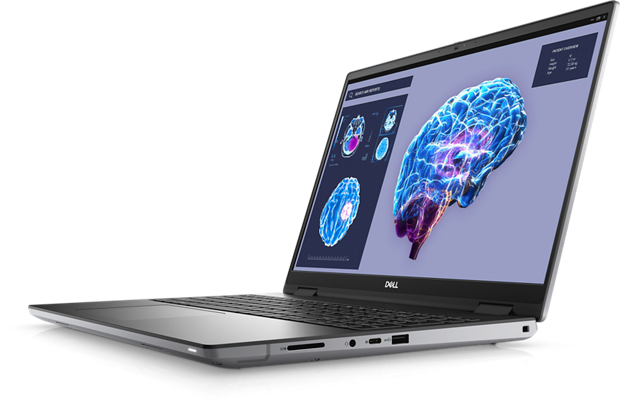New Dell Precision 7680

- Thinkpad P15 (February 2022)
- Thinkpad P50 (April 2017)
- Thinkpad W530 (March 2013)
- Thinkpad T61p (June 2008)
- Intel(R) Core(TM) i7-13850HX CPU @ 2.10GHz (4608 bogomips in Linux)
- 64GB RAM
- Samsung 2TB NVMe SSD
- 16" UHD+ 3840x2400 OLED, touch, 400 nits
- Integrated Li-Po battery
- Wi-Fi 6
- NVidia RTX 4000 12GB
- Front Facing Web IR Camera, HDMI Out, Headphone, 2x USB3.2, 3x USB-C3.2 Gen 2, GBit Ethernet, Fingerprint Reader, SD card reader
These are some pretty top level specs. Sure, you can go higher on a few bits and pieces but as the specs stack up, this is clearly the most powerful machine I've had to date. The doubling of RAM should be very helpful as well as the increase from 4GB (old laptop) to 12GB (this laptop) in GPU RAM should also help a lot. I don't imagine I'm likely to be able to run especially big LLMs on this machine but with the extra GPU RAM I should have more space for screen recordings while still running other apps that rely on GPU such as Firefox or vscode. The 28 concurrent thread capability over 20 cores should give more parallel processing capability but the processor operates at a lower clock frequency by default than my previous machine which I assume leads to the lower bogomips figure. That said, the turbo frequency of this processor looks to be pretty decent at 3.8GHz and maxing out at a whopping 5.3GHz. Hopefully, the lower clock speed will help with battery life as well.
In terms of the looks of the machine, I would say it's an improvement over the Thinkpad series. But then that's not especially hard as Thinkpads, even to this day, are large bulky monsters that are very blocky to look at but rock solid for robustness and usability. The new Dell machine is also a bulky monster by any standards, it's just not quite as bulky and monstrous! It has a very pretty looking OLED screen which is highly glossy like a lot of Mac machines. This looks wonderful on the surface but it does offer a vastly increased amount of screen reflection which is fantastic if you want to blank the screen to do your hair by using the gloss as a mirror, but not-so-good if you actually want to see what's on screen. I lament the lack of buttons and the Thinkpad's tracking "nipple" on the Dell but I'm slowly getting used to the gestures on the trackpad i.e. two finger touch for right-click and three finger touch for middle-click. So overall, it offers an improved look to the machine, it's smaller and lighter with a screen that reaches the edge instead of having a huge bezel. However, I wonder if because of that whether it will last as long, I don't like the track pad as much and the keys on the keyboard are a bit smaller. There are also some stupid choices about keys on the keyboard. For example, they have the standard function lock idea for overloading the F-Keys with useful things like volume up/down. However, there's a dedicated "calculator" button and a few other weird choices that mean there isn't room for dedicated page up/down buttons or dedicated home/end buttons which I find extremely annoying.
Hardware compatibility with Linux is going to be hard to beat for the Dell when compared to a Lenovo machine. Lenovo certify their machines for Linux, they offer components that can be updated using open access to firmware. So aside from the usual issues you have with proprietary nonsense with NVidia, the Lenovo machines are very strong on compatibility. The Dell, as expected, isn't quite there. We have the same NVidia nonsense as always, but that's not going away any time soon on any machine. But when examining the firmware, there's a much smaller selection that can be easily updated through Linux. Then we move to the Camera which, fortunately on my machine, actually works. However, there's a ton of (particularly MIPI) cameras on Dell machines that have caused Linux users a real headache. The interesting technical challenge I've had with this machine is the fingerprint reader. I found the fingerprint reader on the Lenovo P15 worked out-of-the-box. However, while it worked it wasn't especially good as the recognition on my fingerprint seemed to go down over time (about a couple of weeks) to the extend that it became unusable and I would need to re-register my print(s). That disadvantage outweighed the advantages so I stopped using if pretty quickly. The Dell has a Broadcom BCM58200 sensor (USB ID 0a5c:5843 for reference) which does not work out-of-the-box. Well not on Fedora anyway! I found some firmware for it on Ubuntu and have managed to get it working on Fedora by compiling up and installing my own RPMs - that's a story for another blog post.
It's going to be a really interesting journey as I migrate from Lenovo (on which I type at the moment) to the Dell (which is currently copying files from this machine). I wonder which machine I'll prefer in a few weeks, a month and ultimately a few years time when the next laptop arrives - whatever that may be!